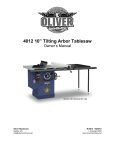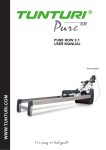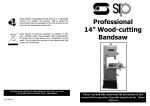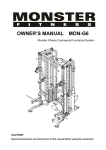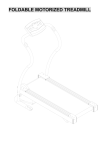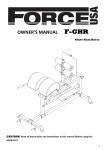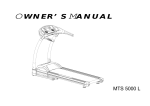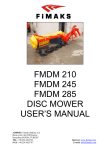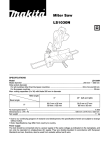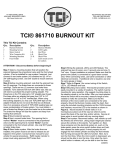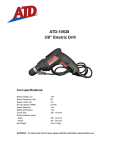Download 01541 Contractors saw 030611
Transcript
Please dispose of packaging for the product in a responsible manner. It is suitable for recycling. Help to protect the environment, take the packaging to the local amenity tip and place into the appropriate recycling bin. Never dispose of electrical equipment or batteries in with your domestic waste. If your supplier offers a disposal facility please use it or alternatively use a recognised re-cycling agent. This will allow the recycling of raw materials and help protect the environment. FOR HELP OR ADVISE ON THIS PRODUCT PLEASE CONTACT YOUR DISTRIBUTOR Ref:070611 28 01541 Contractors Saw Please read and fully understand the instructions in this manual before operation. Keep this manual safe for future reference 1 TROUBLESHOOTING Problem Possible cause Possible solution Table saw does not start: • • • • • Power Switch does not op- • erate: • • Mains lead is not connected to the mains supply. Circuit fuse is blown. Circuit breaker has tripped. Mains lead or Switch is damaged. • • • Power Switch contacts • are burned out. Capacitor is defective. Wiring connections are • loose or damaged. • Fuses or circuit breakers • blow or open frequently: • • • Table Saw is noisy when • running: 2 Motor is overloaded. Fuses or circuit breakers are wrong size or defective. Dull saw blade. Power Switch or motor is defective. • • • • Motor is loose or defec- • tive. 27 Connect the mains lead to the electrical outlet. Replace circuit fuse. Reset circuit breaker. Have the Mains lead or Switch checked, repaired or replaced. Have the Power Switch checked, repaired or replaced. Have the Capacitor checked, repaired or replaced. Have the wiring connections checked / repaired. Feed work-piece more slowly. Replace fuses or circuit breakers. Replace the saw blade. Have the Power Switch or motor checked, repaired or replaced. Have the Motor checked /repaired. CONTENTS TROUBLESHOOTING Problem Possible cause Motor is slow or weak: • • • • Possible solution Voltage from source is • low. Windings are burned out or open. • NVR Switch is defective. Circuit is overloaded with appliances lights or • other electrically powered equipment • Voltage from source is • low. Dull saw blade. Sawdust inside table • saw is blocking airflow. • Request a voltage check from the local power company. Replace the saw blade. Clean out the saw base. blade teeth are dull. • Work-piece is warped. Rip fence is not parallel • with the saw blade. Sharpen or replace the blade. Replace the workpiece. Re-align the rip fence, and lock it in position. Rip Fence does not move • smoothly: Rip Fence is mounted • incorrectly. Remove, and reposition the Rip Fence and lock it in position. Bevel & Height Handles are • hard to turn: Sawdust has collected • on the mechanisms inside the saw. Clean and lubricate the mechanisms inside the base. Table saw vibrates exces- • sively: • • Floor surface is uneven. V-belt is damaged. Saw blade is damaged. Loose bolt, Screws, Nuts. • Sit the saw on a level surface. Replace the V-belt. Replace the Saw Blade. Tighten all Hardware. Motor regularly overheats: • Request a voltage check from local power company. Have the Motor checked, repaired or replaced. Have the NVR switch checked, repaired or replaced. Do not use other appliances or electrically powered equipment on the same circuit when using the Table Saw. • • When ripping, the cut • burns the work-piece, or • stalls the motor: • • • 26 • • • Page No. Description 3. Contents 4. General Safety Instructions 6. Specific Safety Instructions 7. Safety Symbols 7. Getting To Know Your Saw 8. Contents And Accessories 10. Technical Specifications 11. Guarantee 11. Electrical Connection 12. Assembly Instructions 22. Operating Instructions 24. Maintenance 26. Troubleshooting 3 GENERAL SAFETY INSTRUCTIONS MAINTENANCE….cont Please read the following instructions carefully, failure to do so could lead to serious personal injury. When using electric tools, basic safety precautions should always be followed to reduce the risk of fire, electric shock and personal injury. Read all these instructions before operating the tool and save this user manual for future reference. SIP recommends that this tool should not be modified or used for any application other than that for which it was designed. If you are unsure of its relative applications do not hesitate to contact us and we will be more than happy to advise you. KNOW YOUR POWER TOOL: Read and understand the owner's manual and labels affixed to the tool. Learn its applications and limitations, as well as the potential hazards specific to this tool. KEEP WORK AREA CLEAN AND WELL LIT: Cluttered work benches and dark areas invite accidents. Floors must not be slippery due to oil, water or sawdust etc. DO NOT USE THE TOOL IN DANGEROUS ENVIRONMENTS: Do not use power tools in damp or wet locations, or expose them to rain. Provide adequate space surrounding the work area. Do not use in environments with a potentially explosive atmosphere. KEEP CHILDREN AND UNTRAINED PERSONNEL AWAY FROM THE WORK AREA: All visitors should be kept at a safe distance from the work area. STORE TOOLS SAFELY WHEN THEY ARE NOT IN USE: All tools should be stored in a dry, locked cupboard wherever possible and out of the reach of children. WEAR THE CORRECT CLOTHING: Do not wear loose clothing, neckties, rings, bracelets, or other jewellery, which may get caught in moving parts. Non-slip footwear is recommended. Wear protective hair covering to contain long hair. Roll long sleeves up above the elbow. USE SAFETY GOGGLES AND EAR PROTECTION: Wear CE approved safety goggles at all times, Normal spectacles only have impact resistant lenses, they are NOT safety glasses. A face or dust mask should be worn if the operation is dusty and ear protectors (plugs or muffs) should be worn, particularly during extended periods of operation. PROTECT YOURSELF FROM ELECTRIC SHOCK: When working with power tools, avoid contact with any earthed items (e.g. pipes, radiators, hobs and refrigerators, etc.). It is advisable wherever possible to use an RCD (residual current device) at the mains socket. STAY ALERT: Always watch what you are doing and use common sense. Do not operate a power tool when you are tired or under the influence of alcohol or drugs. DISCONNECT THE TOOL FROM THE MAINS SUPPLY: When not in use, before servicing and when changing accessories such as cutters, blades etc. AVOID UNINTENTIONAL STARTING: Make sure the switch is in the OFF position before connecting the tool to the mains supply. NEVER LEAVE THE TOOL RUNNING / CONNECTED WHILST UNATTENDED: Turn off the tool and disconnect it from the mains supply between jobs. Do not leave machine until it comes to a complete stop. 4 Set the saw blade (4) to max. cutting depth (see page 22). Take off the saw blade guard (2) (see page 21). Take out the table insert (6) (see below). Place the holder wrench (41) on the saw blade flange. Using the wrench (40), turn out the screw (42) in the running direction of the saw blade. Remove the saw blade (4) from the inner flange and pull out in an upwards direction. Clean the blade flange thoroughly before fitting the new blade. Mount and fasten the new saw blade in reverse order to above instructions. Important: Note the running direction. The cutting angle of the teeth must point in running direction, i.e. forwards (see the arrow on the blade guard). Refit blade guard (2). Check to make sure that all safety devices are properly mounted and in good working condition before you begin working with the saw again. Changing the table insert (Figure 38): To prevent increased likelihood of injury the table insert should be changed whenever it is worn or damaged. Remove the saw blade guard (2) (see page 21). Remove the countersunk head screws (38). Take out the worn table insert (6). To fit the replacement table insert, proceed in reverse order. 25 OPERATING INSTRUCTIONS….cont MAINTENANCE Important! Always turn the saw off and remove the plug from the mains supply before all maintenance and / or adjustments. • • • • • • • • Remove dust and dirt regularly from the machine. Cleaning is best carried out with a fine brush or a cloth. Never use caustic agents to clean plastic parts. Keep all safety devices, air vents and the motor housing free of dirt and dust as far as possible. Wipe the equipment with a clean cloth or blow it with compressed air at low pressure. We recommend that you clean the device immediately each time you have finished using it. Clean the saw regularly with a moist, not wet, cloth and some soft soap. Do not use cleaning agents or solvents; these could attack the plastic parts of the equipment. Ensure that no water can seep into the electric parts of the saw. GENERAL SAFETY INSTRUCTIONS...cont DO NOT ABUSE THE MAINS LEAD: Never carry the tool by the mains lead or pull it to remove the plug from the mains socket. Keep the mains lead away from heat, oil and sharp edges. If the mains lead is damaged, it must be replaced by the manufacturer or its service agent or a similarly qualified person in order to avoid unwanted hazards. CHECK FOR DAMAGED PARTS: Before every use of the tool, a guard or other part that is damaged should be carefully checked to determine that it will operate correctly and perform its intended function. Check for alignment of moving parts, free running of moving parts, breakage of parts, and any other conditions that may affect its operation. A guard or other part that is damaged should be correctly repaired or replaced by an authorized service centre unless otherwise indicated in this instruction manual. Have defective switches replaced by an authorized service agent. Do not use the tool if the switch does not turn it on and off. KEEP ALL GUARDS IN PLACE: And in full working order. MAINTAIN TOOLS WITH CARE: Keep tools sharp and clean for the best and safest performance. Follow instructions for lubricating and changing accessories. All extension cables must be checked at regular intervals and replaced if damaged. Always keep the hand grip on the tool clean, dry and free of oil and grease. USE ONLY RECOMMENDED ACCESSORIES: Consult this user manual for recommended accessories. Follow the instructions that accompany the accessories. The use of improper accessories may cause hazards and will invalidate any warranty you may have. REMOVE ADJUSTING KEYS AND WRENCHES: Form a habit of checking to see that keys and adjusting wrenches are removed from the tool before every use. SECURE THE WORKPIECE: Use clamps or a vice to hold the work-piece . This frees up both hands to operate the tool. DO NOT OVERREACH: Keep proper footing and balance at all times. USE THE RIGHT TOOL: Do not use the tool or attachment to do a job for which it was not designed. DO NOT FORCE THE TOOL: It will do the job better and more safely at the rate which it was designed. DO NOT OPERATE POWER TOOLS IN EXPLOSIVE ATMOSPHERES: Do not use the tool in the presence of flammable liquids, gases, dust or other combustible sources. Power tools may create sparks which can ignite the dust or fumes. DO NOT EXPOSE THE TOOL TO RAIN OR USE IT IN WET CONDITIONS: Water entering a power tool will greatly increase the risk of electric shock. HAVE YOUR TOOL REPAIRED BY A QUALIFIED PERSON: The tool is in accordance with the relevant safety requirements. Repairs should only be carried out by qualified persons using original spare parts, otherwise this may result in considerable danger to the user. Changing the saw blade Fig. 37: 24 5 SPECIFIC SAFETY INSTRUCTIONS 1. Use only the blade flange specified for this tool. 2. Be careful not to damage the arbor, flange (especially the installing surface) or NUT. Damage to these parts could result in blade breakage. And / or operator injury. 3. Make sure that the table base is properly secured so it will not move during operation. 4. For your safety; remove the chippings and work debris etc. from the table top and from inside the extraction port before each operation. 5. Avoid cutting nails / screws etc.; Remove all obstructions from the work-piece before cutting. 6. Make sure that all keys and wrenches are removed before switching on the saw. 7. Be sure that the blade does not come into contact with the table and / or table insert when the blade is in operation. 8. Always use the supplied push stick whenever possible. 9. Keep hands out of path of saw blade, never reach around saw blade. 10. Make sure the blade is clear of the work-piece before the switch is turned on. 11. Before making the first cut using the saw, turn the blade by hand to ensure nothing is catching, then turn the saw on and let it run for a while; Watch for vibration or wobbling that could indicate poor installation or a poorly balanced blade. Adjust or replace as necessary. 12. Allow the blade to run up to full speed before cutting. 13. Stop operation immediately if you notice anything abnormal. 14. Wait for the saw blade to stop completely and remove from mains supply before servicing or adjusting tool. 15. Be alert at all times, especially during repetitive, monotonous operations. Don't be lulled into a false sense of security. Blades are extremely unforgiving. 16. Use of improper accessories such as abrasive wheels may cause damage to the saw and surrounding area as well as increasing the risk of injury. 17. Turn off the saw and wait for it to complete stop before moving work-piece or changing settings. 18. Do not modify the saw to do tasks other than those intended. 19. Be sure to use a push stick (3) when making longitudinal cuts in work-pieces smaller than 120 mm in width and wherever possible. A push stick is supplied with the saw! CAUTION: The warnings and cautions mentioned in this user manual can not cover all possible conditions and situations that may occur. It must be understood by the operator that common sense and caution are factors which cannot be built into this product, but must be applied. 6 OPERATING INSTRUCTIONS….cont The Rip-Fence (7) should be slid onto the Rip-Fence carrier (17) from the right hand side. Set the Rip-Fence (7) to the required distance from the blade, and lock in place by pressing down on the ripfence lock lever (9). The rip-fence should always run parallel to the blade. On / Off (NVR) Switch: Once fully assembled and adjusted, and all safety precautions have been followed; the saw is ready to be run. To start the saw; press the green (I) button. To stop the saw; press the red (0) button. Your SIP Contractors Saw is fitted with a safety NVR (No Volt Release) switch. This means that if power is cut to the saw (such as in a power failure); the motor will not start to run once the power is returned without the operator following the above instructions to restart the saw. Using the wheel kit (15): To swing the wheel kit out, lift the saw at the back (a) and push / pull the wheels backwards (15) (b). Then lower the saw again, keeping it in this same position (c). The saw is now standing on the wheels and can be transported by one person with the aid of the handles (16). Important: After transportation, the wheel kit (15) must immediately be retracted in order to ensure that the saw is standing securely on its legs. To do this, return the wheels to their starting position by following the sequence in reverse. 23 SAFETY SYMBOLS OPERATING INSTRUCTIONS • • • • • • • Always turn the saw off and remove the plug from the mains supply before making any checks / adjustments. After every new adjustment we recommend you to make a trial cut in order to check the new settings. Always turn the blade by hand prior to operation to ensure that nothing is catching or binding. After switching on the saw, wait for the blade to reach its maximum speed of rotation before commencing with the cut. Take extra care when starting the cut! When using the saw always ensure the operator as well as those in the area wear ear protection. When using the saw always ensure the operator as well as those in the area wear eye protection. Setting the blade height and angle: • Turn the blade height adjust handle (8) clockwise to raise the cutting height, and anti-clockwise to lower the blade cutting height. Loosen the angle locking screw (28) and set the desired angle on the angle scale (40). Re-tighten the locking screw. • • Some wood and wood composites have the potential to be highly toxic; always wear a face mask when operating saw. GETTING TO KNOW YOUR SAW The angle adjustment function has an adjustable stop (39) at 0° und 45°. For angles slightly greater than 45° or less than 0°, the angle stop can be swung away. Note: The blade height should be set to just above the work-piece height. Rip-Fence: The Rip-Fence (7) has two different guide faces (23). For thick material you should use the rip-fence extension (23) as shown in Fig. 34, for thin material you must use the extension as shown in Fig. 35. The Rip-Fence (7) should to be used when making longitudinal cuts in wooden work-pieces. The Rip-Fence (7) should be mounted on the righthand side of the saw blade (4). 22 7 GETTING TO KNOW YOUR SAW….cont ASSEMBLY INSTRUCTIONS….cont To adjust the rip fence carrier (17): • Raise the blade to its highest position using the height adjust crank (8). Fit the rip fence (7) over the carrier (17) and slide the rip fence up to the blade. Slide the carrier so that the zero mark on the scale (12) is directly under the mark on the rip fence. Lock the rip fence in position with the rip fence clamp (9). Ensure that the rip fence is level with the main saw table and tighten the nuts from fixing kit F previously fitted, see Fig. 15 & 16 to secure in place. • • • • CONTENTS AND ACCESSORIES • • • Mount the saw blade guard (2) on the riving knife (5) so that the screw (36) fits through the hole (35) in the riving knife. Fig. 31. Do not tighten the screw (36) too far – the blade guard must be able to move freely. Fasten the extractor hose (13) to the extractor adapter (14) and to the extractor socket of the blade guard (2). Fig. 31 & 32. A suitable extractor system has to be connected to the outlet of the extractor adapter (14). To remove the saw blade guard, proceed in reverse order. Important! The blade guard (2) must always be lowered over the blade prior to each operation. 8 21 CONTENTS AND ACCESSORIES….cont ASSEMBLY INSTRUCTIONS….cont • • • The stop rail must move parallel to the saw table at a distance of approximately 1 mm. To achieve this; loosen the bolts for the sliding rail mounting brackets (19) and adjust in such a way that there is a 1 mm gap between the rail and the saw table along the length of the rail. Re-tighten the bolts to secure in position. See Fig. 27. To fit the rear table (10): • Loosely fit the rear extension table to the rear of the main table with the bolts, spacers, washers and nuts from fixing kit C; ensuring that the spacer sits between the main table and the extension table. Fig. 28. Ref No. Description Ref No. Description 1. Main Saw Assembly 17. Rip Fence Carrier 2. Blade Guard 18. Leg Set 3. Push Stick 19. Sliding Rail Support Brackets 4. Blade 20. Sliding Rail 5. Riving Knife 21. Extraction Hose Mount 6. Table Insert 22. Wheel Kit Support Brackets 7. Rip Fence 23. Rip Fence Extension 8. Blade Height Adjust Handle 24. Leg Support Struts 9. Rip Fence Clamp 25. Rubber Feet 10. Rear Extension Table 26. Push Stick Hook 11. On/Off (NVR) Switch 27. Rear Table Supports 12. Rip Fence Carrier Scale 28. Blade Angle Adjust / Lock 13. Extraction Hose 29. Spanner / Wrench 14. Extraction Port 30. Spanner / Wrench 15. Wheel Set 31. Sliding Carriage Stop Rail 16. Moving Handle 32. Sliding Rail Carriage Note: It would be helpful to have 2 persons to carry out this part of the build. • Now fit the rear table supports (27) to the rear leg brace (24) and the back of the rear extension table using the remaining bolts, washers and nuts from fixing kit H. See Fig. 29. Use a flat edge to ensure that the rear extension table is level with the main table and tighten all nuts / bolts to secure. • 20 9 CONTENTS AND ACCESSORIES….cont Ref. D ASSEMBLY INSTRUCTIONS….cont Nut Bolt A. M8 lock nut N/A 8x24 mm 8x15 mm Lock lever & Plastic washer / spacer B. N/A M10x65 10x24 mm N/A Plastic washer / spacer C. M8 M8x25 8x16 mm 8 mm Spacer D. N/A N/A 6x12 mm N/A M6 x 15 Cap-head bolt E. N/A N/A N/A N/A M6x40 Cap-head bolt M6 Thumb-nut F. M6 N/A 6x12 mm 6 mm M6 x 15 mm Coach bolt G. N/A N/A 5x10 mm N/A 15 mm self tapping screw H. M6 M6x15 6x12 mm 6 mm N/A I. M8 M8x20 8x16 mm 8 mm N/A Desc. Washer Spring Washer Misc. • Slide the carriage (32) over the sliding rail (20) from either the front of the back of the rail as shown in Fig. 24. Caution: To avoid damage or injury, do not attempt to assemble or use the saw if any parts are missing or damaged. IF ANY ITEMS ARE MISSING or DAMAGED; CONTACT YOUR DISTRIBUTOR IMMEDIATELY. TECHNICAL SPECIFICATIONS Part number 01541 Input voltage 230v ~ / 50hz Power 2.2 kw (3 hp) Maximum speed (no load) 2860 rpm Blade size Ø 315 mm x 30 mm bore Maximum Depth Of Cut @ 45° 58 mm Maximum Depth Of Cut @ 90° 83 mm Main Table Size 790 mm x 580 mm Extension Table Size 790 mm x 400 mm Net Weight 52 Kg 10 • If there is too much movement / play between the guide bearings and the sliding rail; the lower bearing (33) should be adjusted so that the carriage slides freely. See Fig. 25. • 19 The carriage stops (fixing kit E) should be fitted to the holes either end of the sliding rail as shown in Fig. 26. This will stop the carriage from falling off either end of the rail. ASSEMBLY INSTRUCTIONS….cont GUARANTEE Guarantee: • Using the 4 cap head bolts from fixing kit D; attach the sliding rail (20) to the 2 support brackets (19) in a way so that the rail overhangs more to the front than the rear. See Fig. 21. This SIP Contractors Saw is covered by a 24 month parts and labour warranty covering failure due to manufacturers defects. This does not cover failure due to misuse or operating the machine outside the scope of this manual. In the unlikely event of warranty claims, contact your distributor as soon as possible. Proof of purchase will be required before any warranty can be honoured. Note: Proof of purchase will be required before any warranty can be honoured. ELECTRICAL CONNECTION • • Fit the sliding carriage stop rail (31) to the sliding rail carriage (32) as shown in Fig. 22 & 23 using fixing kits A & B. Ensure that both spacers (29) are fitted between the rail and the carriage. Connecting to the power supply: This SIP Contractors Saw is fitted with a standard 230v ~ 13 amp plug. Before using the saw, inspect the mains lead and plug to ensure that neither are damaged. If any damage is visible have the saw inspected / repaired by a suitably qualified person. If it is necessary to replace the plug a heavy duty impact resistant plug would be preferable. The wires for the plug are coloured in the following way: Note: Do not over-tighten; the stop rail must remain free moving for the purpose of angle adjustment. • During assembly; ensure that the spring washer from fixing kit A is fitted between the locking nut and the washer on the lock lever. The lock lever should be assembled / tightened so that the sliding carriage stop rail can be moved when the lever is released, but can not be moved when the lever is locked. • 18 Yellow / green Blue Brown Earth Neutral Live As the colours of the wires may not correspond with the markings in your plug, proceed as follows: The wire which is coloured blue, must be connected to the terminal marked with N or coloured black. The wire which is coloured brown, must be connected to the terminal, which is marked L or coloured red. The wire which is coloured yellow / green should be connected to the terminal which is coloured the same or marked Always secure the wires in the plug terminal carefully and tightly. Secure the cable in the cord grip carefully. 11 ASSEMBLY INSTRUCTIONS….cont ELECTRICAL CONNECTION….cont Warning: Never connect live or neutral wires to the earth terminal of the plug. Only fit an approved plug with the correct rated fuse (13 amp). If in doubt consult a qualified electrician. • Note: Always make sure the mains supply is of the correct voltage and the correct fuse protection is used. In the event of replacing the fuse always use a 13A fuse. • Note: If an extension lead is required in order to reach the mains supply; ensure that this too is rated for the correct voltage and fuse rating (16 amps). Loosely fit the 2 sliding rail support brackets (19), one at the front left of the saw and one at the rear left; using the bolts previously removed in Fig. 14 and the last 2 bolts , washers and nuts from fixing kit I as shown in Fig. 18 - 19). The lugs on both brackets should face the front of the saw. Note: The cross section of the extension lead should be checked so that it is of sufficient size so as to reduce the chances of voltage drops. • ASSEMBLY INSTRUCTIONS • • • • • • • Unpack the contractors saw and check it for damage which may have occurred in transit. The machine should to be set up where it can stand firmly on a flat level surface. All covers and safety devices have to be correctly fitted and in full working order before the machine is switched on. The saw blade should run freely. When working with wood that has been processed before, watch out for foreign bodies such as nails or screws etc. Always check and remove prior to running the work-piece through the saw. Before you actuate the On/Off switch, make sure that the saw blade is correctly fitted and that the machines moving parts run smoothly. Before you connect the machine to the power supply, make sure the data on the rating plate is the same as that for your mains supply. At the same time, at the rear of the saw; fit the extraction hose mount (21) using the same bolts. As shown in Fig. 19. • • • • Place the main saw assembly (1), table face down, onto a flat level surface. Place the saw onto cardboard, or similar, to reduce the risk of damage. 12 17 Whilst on a flat level surface; ensure that the leg-set is aligned correctly and that the main table is level. Fully tighten all of the screws for the leg-set. Remove the transit packing as shown in Fig. 20. ASSEMBLY INSTRUCTIONS….cont ASSEMBLY INSTRUCTIONS….cont • • • • • Fit the 3 small coach-bolts, washers and nuts (fixing kit F) loosely into the 3 holes on the front edge of the table as shown in Fig. 15. Carefully remove the end cap from the rip-fence carrier (17). Slide the channel on the back of the carrier (17) over the heads of the coach-bolts (H) as shown in Fig. 16. Replace the cap. • • • 16 Fit the 2 short leg struts (24) to the 2 ends of the leg-set (18), and the 2 long leg struts (24) to the 2 sides of the leg set. Loosely secure the struts to the leg set using bolts, washers and nuts from fixing kit (I) as shown in Fig. 6, 7 and 8. Fit the push stick hook to the front right hand leg as shown in Fig. 17. 13 Fit the 4 legs from the leg-set (18) loosely to the main saw assembly (1) using bolts, washers and nuts from fixing kit (I) as shown in Fig. 5. ASSEMBLY INSTRUCTIONS….cont ASSEMBLY INSTRUCTIONS….cont • • • • • Working from the inside; fit the 2 wheel kit brackets (22) to the rear legs from the leg-set (18). Secure in place with bolts, washers and nuts from fixing kit (H) as shown in Fig. 9. • Fit the four rubber feet (25) to each of the legs from the leg-set (18) by pressing them over the feet as shown in Fig. 10. Secure the feet in place with the metal brackets and bolts, washers and nuts from fixing kit (H) as shown in Fig. 11. Fit the switch / plug box to the outside of the left front leg using the 2 x self tapping screws and 2 x washers (set G) as shown in Fig. 12. Fit the 2 x moving handles (16) to the front legs using the bolts, washers and nuts from set H; as shown in Fig. 13. Note: The handles should move freely and retract automatically as you let go of them. • Turn the saw the correct way up, and stand on a firm level surface. • Note: At least 2 persons are required to turn the saw the correct way to avoid personal injury and / or machine damage. 14 15 Remove the 2 bolts from the left hand side at the front of the saw; as previously fitted in Fig. 5, and the 2 on the same side at the rear of the saw as shown in Fig. 14.














